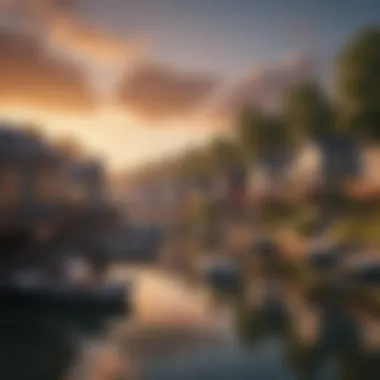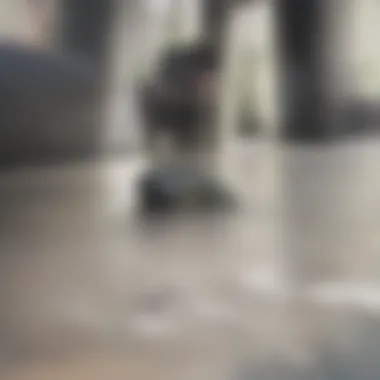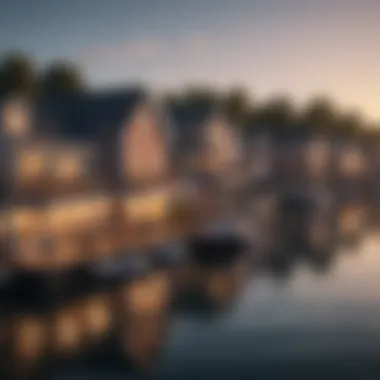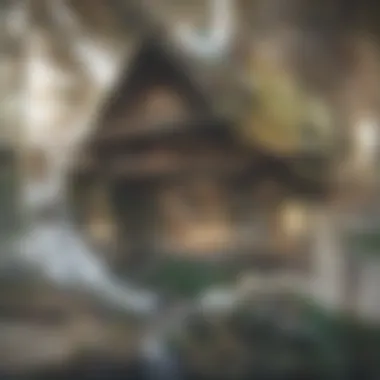Exploring Floating Houses at Whitman Hollow Marina


Intro
Whitman Hollow Marina has recently become a focal point for those intrigued by the innovative concept of floating houses. These structures not only offer a unique living experience but also reflect a growing trend towards sustainable and community-oriented housing. The distinct advantage of living on water, coupled with modern architecture and design, appeals to a variety of individuals. This article examines key attributes of floating houses, including their architectural designs, interior spaces, and community lifestyle that sets them apart from traditional homes.
Exquisite Architectural Designs
The architectural style of floating houses at Whitman Hollow Marina is striking. Each structure is designed to withstand water conditions while providing aesthetic appeal.
Unique Home Features
The floating houses are equipped with features that enhance comfort and functionality:
- Waterproof Materials: High-quality materials ensure durability against the elements.
- Large Windows: Expansive windows offer unobstructed views of the surrounding marina.
- Eco-Friendly Systems: Many houses utilize solar panels for energy efficiency, integrating sustainable practices seamlessly into daily living.
These elements not only elevate the living experience but also promote an environmentally friendly lifestyle.
Historical Significance
The concept of floating houses is not new, but its resurgence is notable in contemporary discussions on housing solutions. Whitman Hollow Marina plays a key role in this revival. This area reflects the shift toward innovative living spaces that respond to challenges of urbanization and climate change. Floating homes offer a solution, addressing land scarcity while fostering a sense of community that is often missing in traditional neighborhoods.
"The architectural advancements in floating houses serve as a symbol of adaptability within modern residential solutions."
Interior Decorating Tips
Designing a floating house requires careful consideration to maximize space and functionality while maintaining style.
Color Schemes and Trends
Choosing the right color palette is crucial. Soft blues and greens complement the water view, creating a sense of tranquility. Bright accents can bring energy and liveliness to the interior.
- Neutral Tones: Base colors like whites and greys can provide a calm background.
- Natural Elements: Incorporate wood and stone materials for an organic feel that connects to the surrounding environment.
Space Optimization Techniques
Living on water often means facing limitations in space. Here are some ways residents can optimize their living area:
- Multi-Functional Furniture: Using furniture that serves more than one purpose can save valuable space.
- Vertical Storage Solutions: Create additional storage by utilizing vertical space, such as tall shelves or wall racks.
These strategies allow for a practical yet stylish interior that feels comfortable and open.
Prolusion to Whitman Hollow Marina
The concept of floating houses at Whitman Hollow Marina presents a unique intersection of architecture, environment, and community. Understanding this topic sets the stage for appreciating the innovative nature of modern housing trends. Floating houses represent an alternative lifestyle that emphasizes harmony with nature while providing a modern way of living. Their design addresses not only functional needs but also aesthetic desires, showcasing how residential solutions can thrive in challenging environments.
Location and Historical Significance
Whitman Hollow Marina is strategically located around scenic water bodies, known for its historical significance tied to the development of recreational activities in the area. Originally designated for boating and fishing, the marina has transformed into a picturesque space for floating houses. This transition reflects broader trends in residential living, highlighting a shift towards sustainable practices and innovative housing solutions. The rich history of the marina contributes to its character, showcasing a blend of past and present. Recognizing this historical backdrop is essential for understanding the cultural weight floating houses carry and their evolution in the housing market.
Overview of Floating House Concept
Floating houses, by their very design, challenge conventional notions of home. These structures provide the essence of a waterfront lifestyle, enabling residents to live on the water while enjoying the benefits of modern amenities. The idea of floating houses emphasizes adaptability, resilience, and a unique approach to real estate. These homes are constructed to cope with fluctuating water levels and weather conditions, making them innovative solutions for areas prone to flooding.
Floating homes are often built with eco-friendly materials and sustainable practices, aligning with contemporary values regarding environmental consciousness. These factors make the floating house concept appealing to both potential homeowners and investors. Furthermore, the community that forms around floating houses at Whitman Hollow Marina fosters a unique lifestyle that promotes interaction and camaraderie among residents.
"The floating houses of Whitman Hollow Marina are not just structures; they are a testament to sustainable living and innovative architectural design that harmonizes with nature."
As we delve deeper into the floating houses at Whitman Hollow Marina, we will explore their design, sustainability aspects, community dynamics, and market trends, providing a comprehensive understanding of this fascinating residential alternative.


Design and Architecture of Floating Houses
The design and architecture of floating houses are crucial aspects to consider when exploring their overall appeal and functionality at Whitman Hollow Marina. This section elaborates on the various elements that define these structures, detailing their benefits and the practical considerations that come with them. Floating houses present not only unique living experiences but also a blend of innovative architectural practices designed to meet modern sustainability standards. Understanding these facets is key to appreciating why floating houses are becoming a significant choice in waterfront living.
Structural Considerations
When examining floating houses, structural integrity is paramount. These homes must withstand changing water levels, current forces, and even strong winds. Therefore, they are often constructed with reinforced materials and buoyant foundations, allowing them to adapt to their aquatic environment.
Common materials used include:
- High-density polyethylene for floats,
- Steel frames for stability,
- Reinforced concrete where necessary to ensure durability.
Moreover, architects consider factors like weight distribution and load-bearing capabilities. This ensures that the homes remain stable regardless of external conditions. Innovations like amphibious designs further showcase the adaptability of these structures, allowing them to float during floods and rest on solid ground otherwise.
Aesthetic Elements
Aesthetic considerations greatly influence the popularity of floating houses. The design often incorporates natural elements, such as large windows for panoramic views and open layout concepts that blend indoor and outdoor spaces. The choice of colors and materials is typically inspired by the surrounding environment.
Typical aesthetic features include:
- Wooden exteriors that enhance warmth and integrate the home with nature,
- Sleek, modern finishes that appeal to contemporary tastes.
Landscaping around these homes often includes native plants, which not only look appealing but also support the local ecosystem. The architecture aims to create a harmonious blend with the waterfront environment, drawing residents outside and fostering a connection with nature.
Interior Design Trends
The interiors of floating houses also reflect modern design trends. Many owners opt for minimalistic styles, using open spaces to create airy, light-filled atmospheres. Smart home technology is increasingly integrated, showcasing advancements in sustainability and convenience. Features might include:
- Energy-efficient appliances to minimize ecological footprints,
- Solar panels positioned on rooftops for renewable energy production.
Moreover, materials used in interior design often focus on sustainability. Bamboo flooring and recycled materials are common, reflecting the growing trend of environmental consciousness. The spaces are designed for functionality, with an emphasis on maximizing small areas while maintaining comfort.
"Floating houses are not just structures; they are innovations that reflect a new way of living."
Sustainability and Environmental Impact
Understanding sustainability in floating housing is critical. Floating houses at Whitman Hollow Marina present an opportunity to witness innovative, eco-friendly living while minimizing environmental footprints. Their unique design integrates with nature, raising important discussions around sustainable practices, materials, and their implications on the local ecosystem. Each element serves to balance comfort and environmental responsibility, making it relevant to current housing dialogues.
Eco-friendly Materials
Floating houses emphasize the use of eco-friendly materials. This choice is essential for reducing environmental degradation. Common materials include reclaimed wood, bamboo, and sustainable composites. These not only provide durability but also minimize resource depletion.
- Reclaimed wood: Offers a sustainable alternative to newly harvested timber. The aesthetic appeal and uniqueness of reclaimed wood cannot be overstated. Each piece carries a story of its past, and its use in construction contributes to reducing waste.
- Bamboo: Fast-growing and requiring less environmental impact during cultivation, bamboo is an excellent choice for structural elements. Its strength and flexibility make it suitable for various design needs.
- Sustainable composites: Often made from recycled plastics and biomass, these materials serve to enhance the longevity of floating homes while maintaining environmental integrity.
The incorporation of these materials not only supports sustainability but enhances the overall aesthetic value of the floating houses.
Energy Efficiency
Energy efficiency in floating homes is a pivotal aspect of their design. These houses often utilize solar panels and other renewable energy sources to power the needs of their residents. This reduces reliance on non-renewable energy and supports a sustainable lifestyle.
- Solar installations: By harnessing solar energy, residents can significantly lower energy costs and their carbon footprint. Systems can be tailored to individual energy requirements, making them versatile solutions for modern living.
- Insulation techniques: Advanced insulation reduces energy consumption for heating and cooling. This ensures that energy expenditure aligns with sustainable living practices.
- Smart home technology: This tech can enhance energy management, allowing homeowners to monitor and optimize their energy usage efficiently.
In essence, energy efficiency in floating houses contributes to their overall appeal while proactively addressing global energy challenges.
Impact on Local Ecosystem
The impact of floating houses on the local ecosystem is a nuanced matter. While they occupy water bodies, proper planning aims to mitigate adverse effects. Floating homes can be designed in a way that they coexist with local flora and fauna.


- Minimal land disruption: These homes eliminate extensive land clearing necessary for traditional housing, preserving valuable habitats.
- Water filtration: Some floating designs incorporate systems that can purify and filter water, improving local water quality and fostering better biodiversity.
- Wildlife interaction: Thoughtful design considers the local wildlife, encouraging natural interactions without disturbing their habitats. Floating houses can become part of the ecosystem, providing unique opportunities for wildlife.
Community and Lifestyle at Whitman Hollow Marina
At Whitman Hollow Marina, the community and lifestyle are deeply intertwined with the unique character of floating houses. This aspect highlights how residential proximity to water can create a vibrant social atmosphere. Living on the water offers both challenges and rewards that are distinct from traditional land-based communities.
Residential Community Dynamics
The residential dynamics at Whitman Hollow Marina are shaped by a close-knit community. Here, neighbors often become friends, sharing experiences unique to floating living. Many residents engage in organized activities and volunteer efforts that enhance communal bonding. The openness of the environment encourages casual interactions, fostering a sense of belonging.
Residents often partake in community meetings to address any issues and to plan events, which strengthen relationships. The floating lifestyle also promotes an understanding of the fluctuating natural surroundings, encouraging a shared responsibility for environmental stewardship. This collaborative element elevates the quality of life and enhances enjoyment for everyone.
Recreational Activities
The recreational opportunities available around Whitman Hollow Marina add significant value to the lifestyle of its residents. Water-based activities, such as kayaking, paddleboarding, and fishing, are especially popular. These options enable individuals and families to immerse themselves fully in the aquatic environment, enjoying daily access to natural beauty and serene experiences.
Moreover, the marina organizes social events, including community BBQs and seasonal festivals. These events strengthen connections and encourage participation across different age groups. The unique setting also provides various avenues for artistic expression, from photography to painting, inspired by the picturesque surroundings.
Challenges of Floating Living
However, floating living is not devoid of challenges. Residents must contend with issues related to maintenance and safety. Regular upkeep of the structure is essential due to exposure to moisture and varying water levels. Additionally, regulating utilities can present logistical difficulties and may require unique solutions compared to traditional homes.
There are also challenges posed by weather conditions. Residents must be cautious during storms or extreme conditions, emphasizing the need for robust design and preparedness. Such considerations, while daunting, also present an opportunity for innovation in architecture and community planning.
Addressing these challenges requires creativity and a proactive approach, influencing the overall experience of living at Whitman Hollow Marina.
In summary, the community and lifestyle at Whitman Hollow Marina illustrate the intricate balance between enjoying unique experiences and managing the complexities associated with floating houses. This dynamic fosters a rich tapestry of communal life, making it an appealing choice for many.
Market Trends and Investment Potential
The growing popularity of floating houses at Whitman Hollow Marina reflects a significant shift in the housing market. This phenomenon is driven by a combination of urbanization, environmental concerns, and shifting lifestyles. The unique positioning of floating homes provides alternative options for those seeking residences that blend with nature and fulfill contemporary living demands.
Demand for Alternative Housing
As more urban dwellers face housing shortages and rising costs, the demand for alternative housing solutions is on the rise. Floating houses offer distinct advantages: they utilize water space that may otherwise remain idle, thus increasing the housing supply without contributing to urban sprawl.
Several factors contribute to this changing demand:
- Affordability: In many cities, traditional housing prices have skyrocketed. Floating homes often represent a more affordable option for buyers.
- Lifestyle Preferences: Individuals and families are seeking innovative living spaces that balance nature and modern comforts. Floating houses, set against beautiful watery backdrops, cater to this desire for tranquility and connection with the environment.
- Sustainability Consciousness: A growing number of buyers prioritize eco-friendly living. Floating houses can be designed with green technologies, making them attractive choices for those who value sustainability.
Financial Considerations
Investing in a floating house involves various financial considerations that potential buyers should carefully evaluate. Here are some key factors:
- Initial Investment Costs: The upfront expenses for purchasing or building a floating home are typically higher than those for traditional homes due to specialized construction and materials.
- Insurance and Financing: Insuring a floating home may vary from standard homeowners' insurance. Buyers should assess policy options that cover unique risks associated with living on water.
- Maintenance and Upkeep: Floating homes often require specific maintenance procedures that can incur additional costs. Factors like fluctuating water levels and exposure to moisture are crucial to factor into long-term maintenance plans.
- Market Resale Value: The floating house market is still developing. Buyers must consider potential future value and market fluctuations when making investments.
Evaluating these financial aspects is essential for determining whether a floating house aligns with individual economic goals.
Future of Floating Homes
The future of floating homes at Whitman Hollow Marina appears promising. With increasing urban density and housing pressures, the trend toward floating homes is gaining momentum.
Several elements are likely to shape this future:
- Regulatory Changes: As demand grows, there might be changes in regulations that facilitate floating house development, potentially making it easier for owners and builders alike.
- Technological Advancements: Innovations in construction materials and sustainable technologies will likely enhance the viability of floating homes. This could lead to more efficient designs and energy systems.
- Cultural Shifts: As more people become accustomed to, and even enamored with, the idea of floating living, we may see a cultural shift that embraces this lifestyle.
"Floating houses not only present an innovative residential solution but also pave the way for a more sustainable future in urban living."


The increased viability and interest in floating homes represent a fascinating development in modern residential architecture. The interplay of market trends and investment potential will be crucial in realizing the full promise of floating living at Whitman Hollow Marina.
Comparison with Traditional Waterfront Living
The exploration of floating houses at Whitman Hollow Marina reveals a compelling alternative to traditional waterfront living. This topic is significant as it highlights both the benefits and considerations of residing on water, providing insights into a lifestyle that is both innovative and fully integrated into the aquatic environment.
Advantages of Floating Houses
Floating houses present a unique set of advantages that appeal to those looking for different housing solutions. One primary benefit is the potential for breathtaking waterfront views. Being on the water allows residents to enjoy expansive scenery that changes with tides and seasons, enhancing their living experience.
Moreover, floating houses generally experience less moisture-related problems compared to traditional homes, which are often built on land that may face flooding risks. This construction style inherently offers a layer of protection against rising water levels.
- Minimal Land Usage: Floating houses do not require land in the same way as conventional homes. This aspect may alleviate pressures on scarce land resources in desirable waterfront areas.
- Sustainability: Many floating homes are designed with sustainability in mind, employing eco-friendly materials and energy-efficient systems. This trend aligns well with growing environmental awareness.
Additionally, floating living promotes a unique sense of community among residents. The novelty of living on water often draws like-minded individuals, fostering connections that might be less common in traditional neighborhoods. The shared experience of floating living can enhance social cohesion.
Limitations of Floating Structures
While the allure of floating houses is evident, there are limitations that potential buyers or renters must consider. One significant limitation is the reliance on water infrastructure. Access to utilities like water, electricity, and sewage management can sometimes be less straightforward than in traditional homes, potentially complicating ownership.
- Cost of Maintenance: Floating homes can incur higher maintenance costs over time. The marine environment can accelerate wear and tear, necessitating more frequent repairs than typical homes.
- Insurance and Financing Challenges: Obtaining insurance for floating structures can be more complex and may come at a higher premium. Similarly, financing options may not always be as accessible compared to conventional properties.
Noise and motion from waves could also present an issue for some individuals. While many embrace the experience of living on water, not all may find the gentle rocking or sounds of water to be soothing.
Cultural Perceptions of Floating Living
Cultural perceptions of floating living play a substantial role in shaping the identity and acceptance of floating houses at Whitman Hollow Marina. This topic examines how societal attitudes, influenced by media and personal experiences, form a narrative that impacts the demand and desirability of these unique homes. Floating living is not merely about innovative architecture; it encompasses a broader scope that includes perceptions of sustainability, lifestyle, and community engagement.
Media Representation
The representation of floating houses in various media outlets contributes significantly to public understanding and acceptance. Documentaries and reality shows that feature floating homes tend to highlight their aesthetic appeal and unique positioning. Shows on platforms like HGTV or YouTube often romanticize life on the water, showcasing picturesque settings and the tranquility they offer.
In contrast, some portrayals focus on the potential challenges of floating living, like maintenance and adaptability to environmental changes. For example, articles in design magazines often emphasize eco-friendly aspects. They discuss sustainable materials, efficient use of space, and harmony with nature. This dual representation creates a complex view of floating houses, indicating both desirability and apprehension.
Media representation shapes our views, allowing us to envision life in floating homes while also presenting realistic challenges.
Public Perception
Public perception of floating living is multifaceted. Many people admire the novelty and charm of floating houses, seeing them as pleasurable alternatives to traditional homes. The idea of dwelling on water conjures images of freedom and relaxation. Surveys indicate that individuals, especially in urban areas, are increasingly considering alternative housing options. This trend reflects a growing interest in lifestyle choices that prioritize experiences over conventional property ownership.
Nevertheless, some reservations persist. Concerns about safety, especially during storms or flooding, affect the way people regard floating homes. The fear of instability can deter potential buyers. Understanding these nuanced perceptions is crucial for developers and real estate advisors aiming to market floating houses effectively.
In summary, cultural perceptions of floating living are informed by diverse influences, ranging from media portrayals to public sentiment. The careful navigation of these perceptions can significantly impact the future market for floating houses, as potential residents weigh the enchanting imagery against practical considerations.
Culmination
The importance of concluding an exploration of floating houses at Whitman Hollow Marina lies significantly in synthesizing the multifaceted aspects examined throughout the article. As the narrative has unfolded, the unique allure of floating houses has been highlighted, showing how they are not merely alternative residences but rather a lifestyle choice that integrates with nature.
Summation of Key Points
Floating houses embody a blend of innovation, sustainability, and community living. Key points include:
- Design and Architecture: The distinct structural features and aesthetic elements highlight creativity in housing solutions.
- Sustainability: Eco-friendly materials and energy-efficient designs present an environmentally conscious approach that appeals to modern sensibilities.
- Community Dynamics: The vibrant lifestyle fostered within the marina creates a sense of belonging and engagement among residents.
- Market Trends: The growing interest in alternative and floating housing indicates a shift in consumer preferences, hinting at a new era in real estate.
- Cultural Perception: The representation in media and public attitudes influences how floating living is perceived, indicating both acceptance and challenges.
Understanding these elements helps grasp the overall significance of floating houses as a unique segment within contemporary housing markets.
The Future of Floating Houses
Looking forward, the future of floating houses appears optimistic but requires adaptability to various challenges. Trends suggest:
- Technological Advancements: Innovations in construction methods and materials may enhance the durability and appeal of floating homes.
- Regulatory Frameworks: As floating houses gain popularity, tailored regulations and zoning laws may emerge, affecting future developments.
- Sustainability Efforts: Increasing commitment to environmental stewardship will likely drive demand for energy-efficient and eco-friendly floating homes, potentially shaping design standards.
- Community Innovations: The rise of online platforms and social networks might foster stronger communities within marinas, attracting like-minded individuals.
Floating living is poised to grow, but its success will hinge on careful planning, community engagement, and sustainability initiatives. Emphasizing these factors will be crucial as Whitman Hollow Marina and similar developments evolve in response to an ever-changing housing landscape.















